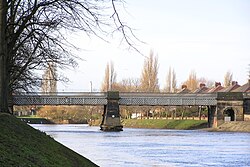York-Scarborough line
| York–Scarborough line | |
|---|---|

Scarborough Railway Bridge, York.
|
|
| Overview | |
| Locale |
North Yorkshire Yorkshire and the Humber York Scarborough, North Yorkshire |
| Operation | |
| Owner | Network Rail |
| Technical | |
| Track gauge | 4 ft 8 1⁄2 in (1,435 mm) standard gauge |
The York–Scarborough line runs between the city of York, England, and the town of Scarborough. Towns and villages served along the way are Malton, Norton-on-Derwent and Seamer.
The line was built by George Hudson's York and North Midland Railway and opened on 7 July 1845. The line was constructed remarkably quickly by the standards of the time, taking just one year and three days to complete the 42-mile route. This feat was possible because the Y&NMR decided against the more costly and time-consuming option of building a tunnel through the Howardian Hills south of Malton. Instead the chosen route meanders with the River Derwent for around four miles, creating a slower but more scenically pleasant experience for passengers
The railway line was opened with a ceremony for invited guests who were taken by George Hudson on a train of two engines and 40 first class coaches, which left York at 11.00 am. The line was initially single track and the journey to Scarborough took three and a half hours. In Scarborough the guests were treated to a lunch. After a return journey to York, the guests were treated to dinner in the Guildhall, hosted by the Lord Mayor of York.
The new railway included a 6-mile branch from Rillington to Pickering that connected with the horse-worked Whitby and Pickering Railway which the Y&NMR immediately proceeded to take over and upgrade for steam traction.
Most of the intermediate stations on the line were closed to passengers in September 1930 as the number of excursion and holiday trains going straight through to Scarborough during that period meant that the line was too busy to accommodate local services. The closed stations retained their goods facilities and were maintained for occasional passenger use by excursion trains until the 1960s.
...
Wikipedia
